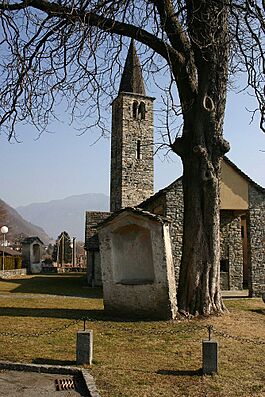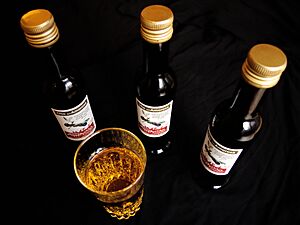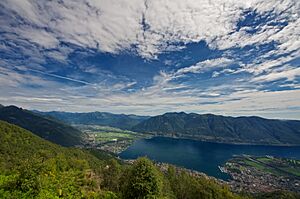Gudo facts for kids
Quick facts for kids
Gudo
|
||
|---|---|---|
 |
||
|
||
| Country | Switzerland | |
| Canton | Ticino | |
| District | Bellinzona | |
| Area | ||
| • Total | 9.94 km2 (3.84 sq mi) | |
| Elevation | 232 m (761 ft) | |
| Population
(December 2004)
|
||
| • Total | 754 | |
| • Density | 75.86/km2 (196.46/sq mi) | |
| Postal code |
6515
|
|
| Surrounded by | Cadenazzo, Cugnasco, Giubiasco, Sant'Antonino, Sementina | |
Gudo was once a separate town in the canton of Ticino in Switzerland. It was located in the Bellinzona district.
On April 2, 2017, Gudo joined several other towns like Camorino, Claro, and Giubiasco to become part of the new, larger city of Bellinzona.
Contents
History of Gudo
Ancient Discoveries
In 1909–1910, workers near the Ticino River in a small area called Progero found an amazing ancient burial ground. This site, known as A Progero, is now a very important Swiss heritage site.
The oldest things found there were pieces of pottery. These show that people probably lived in the area during the Early Bronze Age (around 17th–16th century BC). Later, more pottery was found from the Late Bronze Age (13th–12th century BC).
Most of the graves, over 300 of them, are from the Iron Age (around 6th century BC). This was a settlement of the Golasecca culture, and it lasted until about 200 BC. Most of the graves from this time held full bodies. They were surrounded by stone walls and covered with wood or stones. Sometimes, special stones with carvings were found near the graves.
Many items from the Late Bronze Age graves were bi-conical (two cone-shaped parts joined at the base) or lens-shaped urns (containers for ashes). During the Golasecca era, most graves had ceramic pots like urns, bowls, and mugs. They also had bronze jewelry like brooches, earrings, and belt buckles, plus amber necklaces and beads. One special find was a bronze bucket from around 500 BC. It had carvings in the ancient Lepontic!
The cemetery was still used even after the Golasecca culture. Items from the Latène era were found. When Celtic groups came over the Alps into this region, they settled near Gudo and used the cemetery too. Their graves included ceramic dishes, La Tène brooches, glass and amber beads, and bronze or silver rings.
Gudo in the Middle Ages
The modern village of Gudo was first mentioned in old writings in 1277, called Gudio. By 1264, several important groups owned land in Gudo. These included the Knights Hospitaller (a famous knightly order), the council of Como, and cathedrals from Bellinzona and Locarno.
Gudo officially recorded its citizens' rights in 1363. Progero, the area where the ancient graves were found, was mentioned as a separate community. In Progero, the Church of Santa Maria was rebuilt in the 1600s. Legend says a Benedictine monastery once stood there.
Gudo and Sementina became separate from the main church in Bellinzona in 1440. In 1992, during digs around the parish church of S. Lorenzo, an even older church was found! It dated back to the 6th or 7th century. This is the oldest church building found by archaeologists in the Bellinzona area. The current S. Lorenzo church was built in 1615 and was restored between 1990 and 2000.
Gudo in Modern Times
In 1888, the Ticino River's path was changed, which helped the town's population grow. In 1907, an iron bridge was built, connecting the Magadino Plain to Cadenazzo. From 1932 to 1936, the canton (like a state) built a large farm called Demanio agricolo in Gudo.
Gudo's economy has always been strong in farming, especially in the Lake Maggiore area. The hills around the town are perfect for growing grapes. In the early 1900s, Gudo was a very important center for Ticino's wine industry. The special climate on the right side of the Ticino River is great for making high-quality wines. Even today, Gudo has some of the biggest vineyards in the canton. A unique wine from Ticino is dry white Merlot, and Gudo is known for it.
Today, Gudo is mostly a residential town. Most people who live there work in other communities. The town has a kindergarten and a primary school in the main government building. There are also two hotels, restaurants, and a public park with a new playground.
Cycling is popular in Ticino, so you can find an e-bike charging point near Albergo Garni Anita. Gudo has several bus stops, like Gudo, Serta, which is near the old center and the Progero church. Another stop, Gudo, Progero, is close to the school. The Gudo, Chiesa stop is near Saint Lawrence Church. You can take a number 311 bus to Locarno or Bellinzona.
Geography of Gudo
Gudo covers an area of about 9.94 square kilometers (3.84 square miles). A large part of this land, about 27.2%, is used for farming. Even more, about 61%, is covered by forests. About 5.4% of the land has buildings or roads. Rivers and lakes make up about 3.1%, and a small part, 1.9%, is land that can't be used for anything.
The town is located in the Bellinzona district, at the bottom of the mountains, on the right side of Lake Maggiore. It includes the main village of Gudo and smaller areas like Progero.
Gudo's Coat of Arms
The blazon (description) of Gudo's coat of arms is: Azure a Gril Argent between two Bunches of Grapes Or in base. This means it has a blue background with a silver grill. The grill is a symbol of Saint Lawrence (Santo Lorenzo), who is the special saint of Gudo's church. There are also two golden bunches of grapes at the bottom, showing the importance of wine in the area.
People of Gudo
Gudo has a population of about 811 people (as of 2009). About 16.9% of the people living in Gudo are from other countries. Over the past 10 years (1997–2007), the population grew by about 14.3%.
Most people in Gudo speak Italian (85.1%). German is the second most common language (9.6%), and English is third (1.2%).
In 2009, Gudo had 82 children aged 0-9 (10.1% of the population) and 70 teenagers aged 10-19 (8.6%). The adult population included 79 people aged 20-29 (9.7%), 140 people aged 30-39 (17.3%), and 141 people aged 40-49 (17.4%). There were also 98 people aged 50-59 (12.1%). For seniors, 90 people were 60-69 years old (11.1%), 73 people were 70-79 (9.0%), and 38 people were over 80 (4.7%).
In 2000, there were 304 homes in Gudo, with about 2.2 people living in each home on average. Most of the buildings (77.7%) were single-family homes.
Here's how Gudo's population has changed over time:
| year | population |
|---|---|
| 1671 | 100 |
| 1769 | 150 |
| 1850 | 296 |
| 1880 | 390 |
| 1888 | 583 |
| 1900 | 373 |
| 1950 | 435 |
| 1990 | 501 |
| 2000 | 679 |
Important Heritage Sites
The ancient burial ground called A Progero is recognized as a very important heritage site of national significance in Switzerland.
Economy of Gudo

In 2007, Gudo had a low unemployment rate of 3.91%. Most jobs were in the service industry, like hotels and restaurants. There were also jobs in agriculture (farming) and the manufacturing sector.
In 2000, 75 people traveled into Gudo for work, while 232 people traveled out of Gudo to work in other towns. This means more people left Gudo for work than came in. Most people (73.3%) used a private car to get to work, while a smaller number (4.6%) used public transportation.
In 2009, Gudo had 3 hotels with a total of 26 rooms and 50 beds for visitors.
Religion in Gudo
Based on the 2000 census, most people in Gudo (76.6%) were Roman Catholic. About 8.8% belonged to the Swiss Reformed Church. A small number of people (12.37%) belonged to other churches, and 2.21% did not answer the question about their religion.
Education in Gudo
Switzerland is known for its good education system. In Gudo, about 73.9% of adults (aged 25-64) have finished either high school or gone on to higher education, like university.
In 2009, Gudo had 117 students. The education system in Ticino offers up to three years of optional kindergarten, and in Gudo, 21 children were in kindergarten.
The primary school program lasts for five years. In Gudo, 38 students attended the regular primary schools, and 2 students attended a special school. For middle school, students can either go to a two-year middle school followed by a two-year pre-apprenticeship program, or they can join a four-year program to prepare for university. In Gudo, 21 students were in the two-year middle school, and 20 students were in the four-year advanced program.
After middle school, students have several choices for high school. They can prepare for a trade or continue their studies at a university or college. Some students go to school while also doing an internship or apprenticeship, which takes three or four years. Others go to school full-time for a year or part-time for one and a half to two years, followed by an internship.
In Gudo, 3 students were in full-time vocational training, and 9 were part-time. Three students were in a professional program that prepares them for jobs in fields like engineering, nursing, or business.
In 2000, only 1 student came to Gudo from another town for school, while 47 students from Gudo went to schools outside the town.
See also
 In Spanish: Gudo para niños
In Spanish: Gudo para niños





